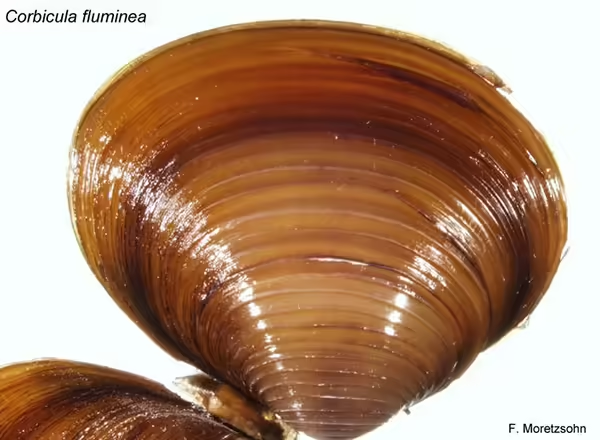
Asian Clam
Asian clam (Corbicula fluminea) also known as Golden Clam is a filter feeder that reproduces rapidly and competes with native species for food and space. It was first found in the Great Lakes in western Lake Erie in 1980 and the species has since been documented in warm-water areas of all of the Great Lakes sub-basins.
Eradication of Asian clams from infested open waters is unlikely so agencies are focused on preventing further spread. Asian clams can be introduced to a waterway by bait buckets, boat movement, natural water currents.

The Asian clam is a filter feeder that reproduces rapidly and competes with native species for food and space.
Large numbers of Asian clams can cause biofouling of power plant and industrial water systems and have also been documented to cause problems in irrigation canals and pipes, as well as in drinking water supplies. The cost of removing Asian clams from water intake pipes has been estimated at about a $1 billion each year in the U.S. They can also increase sedimentation rates within pipes and canals.
Nuclear reactors have had to be closed temporarily for the removal of Asian clams from the cooling systems. In Ohio and Tennessee where riverbeds are dredged for sand and gravel for use as aggregation material in cement, high densities of Asian clams have incorporated themselves in the cement, burrowing to the surface as the cement starts to set and weakening its structure.
Native to Asia, the eastern Mediterranean, Africa and Australia, this clam was introduced to the U.S. in 1938, likely as a food source and has spread into many major waterways. The first record for the Great Lakes was in western Lake Erie in 1980 and the species has since been documented in warm-water areas of all of the Great Lakes sub-basins.
Current modes of introduction include bait bucket introductions, accidental introductions associated with imported aquaculture species, intentional introductions by people who buy them as a food item in markets, larvae transport on boats and fishing equipment, and passive movement via water currents.
Many factors may affect population density and distribution of the Asian clam, including temperature, pollution, competition, predators, genetic changes, and salt and oxygen concentrations, as well as bacterial, viral, and parasitic infections.
Asian clam Regulation
Asian clam is not on the Illinois Aquatic Life Approved Species List and is illegal to be imported or possessed alive without a permit (515 ILCS 5/20-90).
Management of Asian clams
Eradication of Asian clams from infested open waters is unlikely; therefore, the emphasis is on preventing further spread.
Screens and traps are commonly employed to prevent colonization of water intakes. Diver-assisted suction removal and bottom barriers are being researched as potential methods for physical control of Corbicula populations in Lake Tahoe. Benthic barriers have been demonstrated to be effective for short-term control of Corbicula, but non-target mortality to other benthic invertebrates may be high. Alternatively, small filters can be effective at removing larvae.
Before you leave a body of water after boating or fishing, always remove, drain, and dry:
- REMOVE plants, animals, and mud from all equipment. Mud and plant fragments can also hide AIS too small to be seen with the naked eye.
- DRAIN all water from your boat and gear. Boaters should ensure plugs are pulled from bilge and live wells before leaving a waterway. Bait bucket water should be drained on land.
- DRY everything thoroughly with a towel. All equipment that comes into contact with water should be wiped off and dried with quick-dry towel. If possible, dry everything for five days before entering new waters.
Clean other equipment as necessary. Waders and boots should be scrubbed and rinsed with tap or well water. If possible, use hot or high-pressure water to clean your equipment. Using a car wash for your boat and trailer is a great alternative. Full-strength white vinegar or a solution of ¼ cup bleach per gallon of water can be used to disinfect equipment and confined spaces like live wells.
- Illinois-Indiana Sea Grant, Golden Mussel
- U.S. Geological Survey, Nonindigenous Aquatic Species Database; NOAA, Great Lakes Aquatic Nonindigenous Species Information System